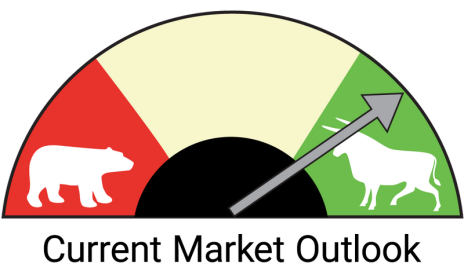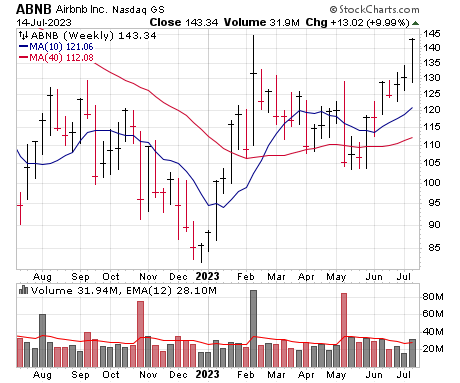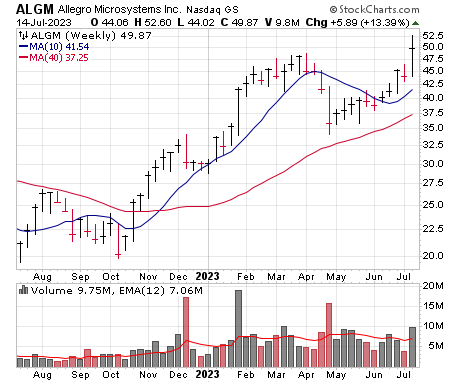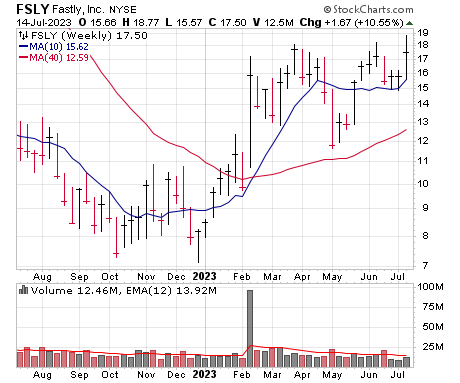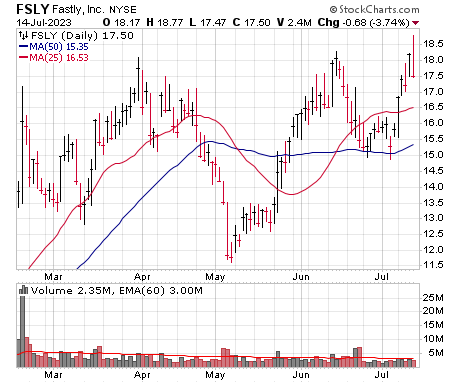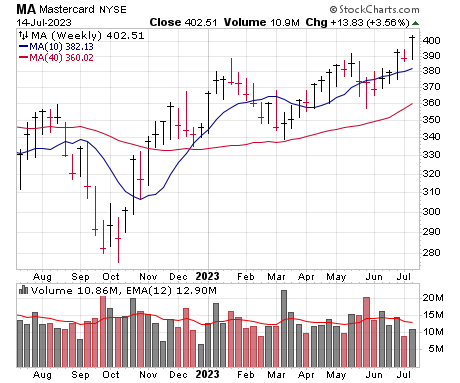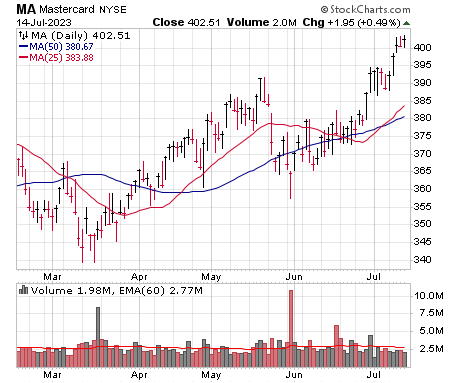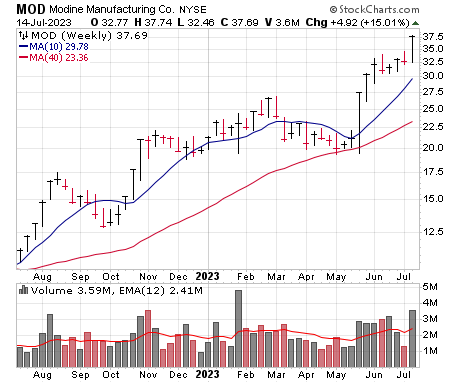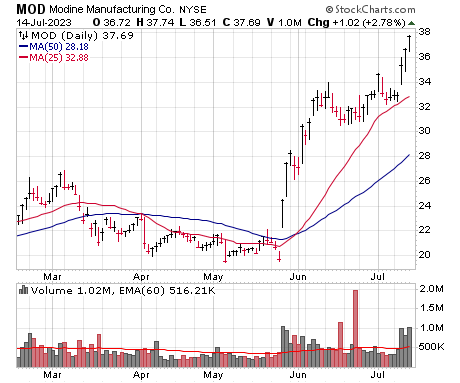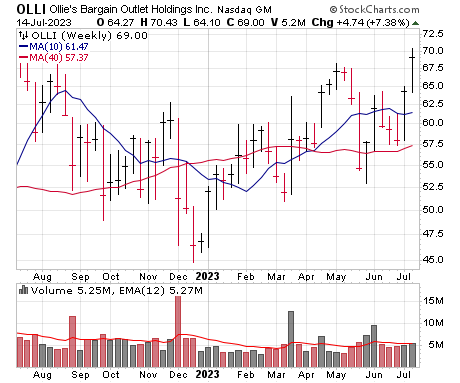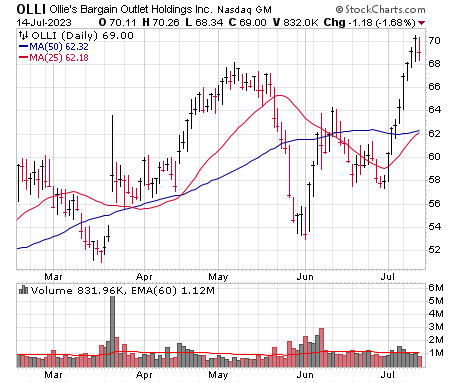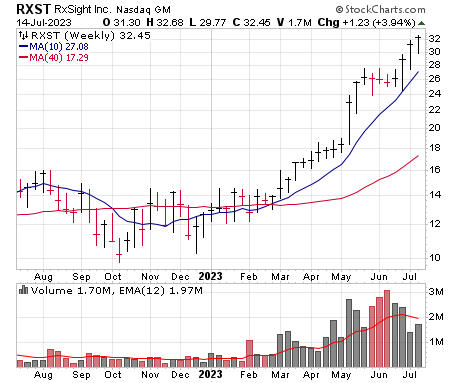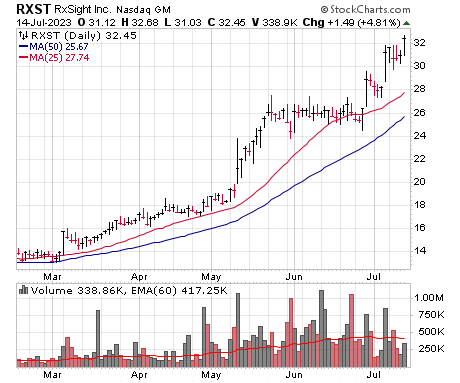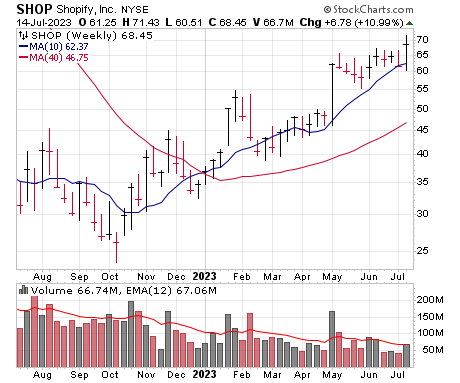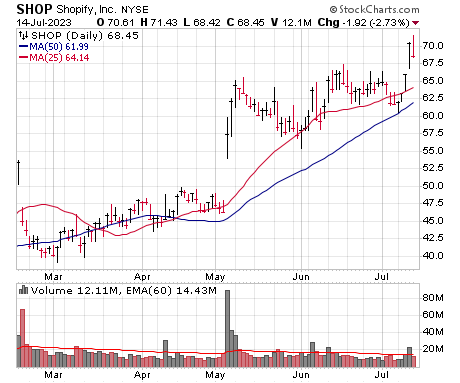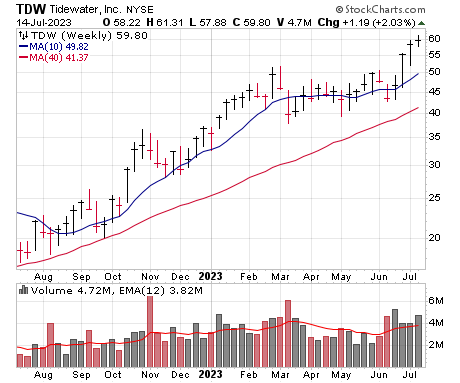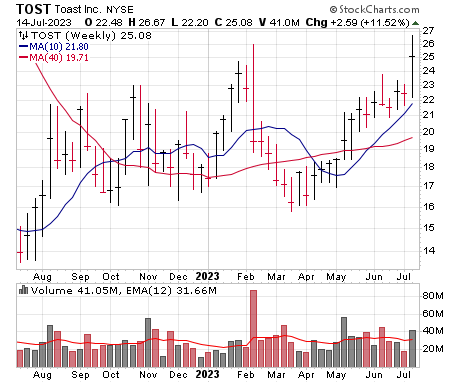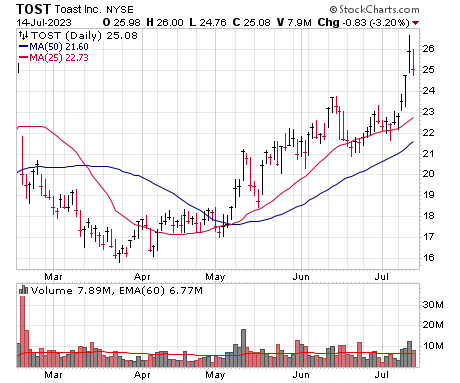Trees vs. Forest
There’s no doubt the market continues to keep investors on their toes—this hasn’t been a completely cohesive situation, with some areas ramping one week, while the next week those rest while separate sectors see buying … all with the occasional pothole or sell-on-strength action showing up (like we saw late last week). As we’ve been writing, further discomfort in the short term is certainly possible after the recent run, and it’s also a decent bet that earnings season, which is now ramping up, will present a few potholes. But those are the trees—if you look at the forest, all of the bullish factors are still in place, whether it’s the uptrend in the major indexes, the solid action among most leading stocks, the sluggishness of defensive stocks and, more recently, the strength of the broad market (including five straight days of 2-to-1 NYSE breadth). We remain bullish and expect higher prices—we’ll leave our Market Monitor at a level 8.
This week’s list has a very broad mix of names, including everything from giant blue chips to more speculative small caps. Our Top Pick is Shopify (SHOP), which is in the right area (big-cap growth) and is trying to emerge from a tight consolidation. Earnings are out in a couple of weeks, so start small and build if the breakout works.
Price |
| Airbnb (ABNB) |
| Allegro MicroSystems (ALGM) |
| Fastly (FSLY) |
| Mastercard (MA) |
| Modine Manufacturing (MOD) |
| Ollie’s Bargain Outlet (OLLI) |
| RxSight (RXST) |
| Shopify (SHOP) ★ Top Pick ★ |
| Tidewater (TDW) |
| Toast (TOST) |
Stock 1
Airbnb (ABNB)
Price |
Why the Strength
While some pockets of travel (like airlines) look extremely healthy, many hotels and the like have been lagging the travel boom—but now we’re starting to see some kick into gear, with investors thinking that group’s strong earnings and cash flow will not just hold up but actually grow going ahead. Airbnb is the 800-pound gorilla in the home rental category, though there have been more than a few worries popping up in recent months: Weaker guidance after the Q1 report (tough comparisons compared to the post-pandemic boom a year ago were a factor) had some thinking others (mainly hotels) were taking share, and there were also signs rental prices could be coming down, too. Still, we think a lot of the fears centered around the fact that the economy could tip into recession—and with inflation cooling, those fears are easing, and some more recent data points (like room growth and continued huge air travel trends) have analysts thinking this year could prove solid. Underlying all of this, too, are great financials—free cash flow here is much, much larger than earnings (about $6 per share in the past year, compared to $3 of earnings; the free cash flow margin was 44% in Q1!), which the top brass is using to buy back stock (share count down 5% in the past year) and introduce multiple products to help sellers and renters, improving the experience. It’s not a new story at this point, but it is something of a “new blue chip,” and it looks like investor perception is finally turning up. A reasonable valuation (on a free cash flow basis) is another plus.
Technical Analysis
ABNB bottomed in December and rallied sharply into February, with a huge earnings gap pushing the stock to 145. That was the high, though, with a tedious decline into the 105 area (after the May quarterly report brought selling) after the Q1 report and aforementioned worries. Now ABNB is making another go at it—the run has been fairly persistent since early June, with shares overcoming some resistance in the 130 area last week and, now, pushing above its February high. As with most things right now, we prefer aiming for dips if you want in.
| Market Cap | $92.0B | EPS $ Annual (Dec) | ||
| Forward P/E | 41 | FY 2021 | -0.57 | |
| Current P/E | 47 | FY 2022 | 2.79 | |
| Annual Revenue | $8.70B | FY 2023e | 3.46 | |
| Profit Margin | 6.4% | FY 2024e | 3.96 | |
| Qtrly Rev | Qtrly Rev Growth | Qtrly EPS | Qtrly EPS Growth | |
| ($B) | (vs. yr-ago-qtr) | ($) | (vs. yr-ago-qtr) | |
| Latest qtr | 1.82 | 20% | 0.18 | N/A |
| One qtr ago | 1.90 | 24% | 0.48 | 500% |
| Two qtrs ago | 2.88 | 29% | 1.79 | 47% |
| Three qtrs ago | 2.10 | 58% | 0.56 | N/A |
Weekly Chart | Daily Chart |
Stock 2
Allegro MicroSystems (ALGM)
Price |
Why the Strength
Allegro is a chipmaker that supports emerging technologies in the end markets of industrial (building and factory automation) and automotive (motors, chargers and batteries). The company is fast becoming a top supplier in the electric vehicle (EV) market, and its automotive sensor ICs are used to measure motion, speed, position and current, while its power ICs enhance motor performance and power management. Automotive is Allegro’s biggest market (nearly 70% of sales in the latest quarter), and to bolster its position the firm bought chip maker Heyday Integrated Circuits last year, which specializes in compact, fully integrated isolated gate drivers that convert high voltages in gallium nitride (GaN) and silicon carbide (SiC) semiconductors—both of which are key to EVs since they’re able to keep up performance even at high temperatures and voltages. The acquisition is also part of Allegro’s strategy to double its share of the e-mobility market (the electrification of vehicles and the energy grid). The company pointed to a “significant increase” in design win momentum during its fiscal year 2023 (ended March 31), with design win activity in fiscal Q4 led by ICs for motor drivers, with additional wins across Asia and Europe for EV charging stations using its sensor IC technology. Revenue in Q4 of $269 million jumped 35% from a year ago (a reason for the strength), led by a 29% increase in sales to auto customers and a 67% sales spike for industrial clients. Meanwhile, per-share earnings of 37 cents beat estimates by a cent. Growth is expected to slow (earnings estimates call for only +13% this year and next), but the backlog here is big (basically a year’s worth of revenue) and Allegro has regularly beaten estimates; the next report is due August 1, with revenues expected to rise 26%.
Technical Analysis
ALGM built a great post-IPO base even through the bear market, and following some tightness in December, the stock exploded to new highs after earnings in late January. That said, the market didn’t let it get far, with shares starting to top a month later and decisively breaking down in April. The comeback started slowly, but was persistent, and recently ALGM leapt to new highs on good volume. We’ll set our buy range down a bit given the recent run and the upcoming report.
| Market Cap | $9.56B | EPS $ Annual (Dec) | ||
| Forward P/E | 35 | FY 2022 | 0.78 | |
| Current P/E | 41 | FY 2023 | 1.28 | |
| Annual Revenue | $975M | FY 2024e | 1.44 | |
| Profit Margin | 26.6% | FY 2025e | 1.62 | |
| Qtrly Rev | Qtrly Rev Growth | Qtrly EPS | Qtrly EPS Growth | |
| ($M) | (vs. yr-ago-qtr) | ($) | (vs. yr-ago-qtr) | |
| Latest qtr | 270 | 35% | 0.37 | 76% |
| One qtr ago | 249 | 33% | 0.35 | 84% |
| Two qtrs ago | 238 | 23% | 0.31 | 55% |
| Three qtrs ago | 218 | 16% | 0.24 | 33% |
Weekly Chart | Daily Chart |
Stock 3
Fastly (FSLY)
Price |
Why the Strength
Fastly’s content delivery network (CDN) accelerates the delivery of videos, images and other online content by storing websites’ cached copies on its “edge” servers (located near the physical location of the user), while also offering security solutions. Fastly’s growth rate slowed after an initial pandemic surge when companies reduced IT spending to control costs, but its customer base continues to increase and it recently added some high-profile clients in its privacy and cybersecurity vertical, including Google and Frontier Airlines, along with additional wins in the life sciences and tech sectors. The additions contributed to an impressive 11% year-on-year increase in enterprise additions in the first quarter that boosted its overall customer base to 3,100. Revenue grew 15% in Q1, to $118 million, with the average enterprise customer spend of $795,000, growing 10%. Indeed, while it’s softening a bit, Fastly’s same-customer revenue growth rate was up 16% to 21%, depending on exactly how it’s measured. And while the company isn’t yet profitable, the per-share loss of nine cents beat estimates by 10% and improved six cents from a year ago, while EBITDA was near breakeven and the firm is successfully paying off wads of debt. Moving forward, the top brass sees revenue up 16% this year, driven by “healthy traffic expansion” from its biggest customers. Analysts, meanwhile, expect the market for Fastly’s offerings to increase by a 15% average annual growth rate in next two years, with cash flow moving into the black next year. The Q2 report is due out August 2.
Technical Analysis
After a giant post-pandemic run, FSLY fell out of favor and ended up crashing to 7 by last October. A couple of months of bottoming ensued, and shares turned the corner in January with a massive-volume, pre- and post-earnings rally that ran to 18 before hitting resistance in late March. FSLY pulled back sharply, but has now revisited resistance near 18 a couple of times without getting through – we’ll set our buy range up a bit from here, thinking further strength will lead to a run.
| Market Cap | $2.22B | EPS $ Annual (Dec) | ||
| Forward P/E | N/A | FY 2021 | -0.48 | |
| Current P/E | N/A | FY 2022 | -0.59 | |
| Annual Revenue | $449M | FY 2023e | -0.25 | |
| Profit Margin | N/A | FY 2024e | -0.03 | |
| Qtrly Rev | Qtrly Rev Growth | Qtrly EPS | Qtrly EPS Growth | |
| ($M) | (vs. yr-ago-qtr) | ($) | (vs. yr-ago-qtr) | |
| Latest qtr | 118 | 15% | -0.09 | N/A |
| One qtr ago | 119 | 22% | -0.09 | N/A |
| Two qtrs ago | 109 | 25% | -0.08 | N/A |
| Three qtrs ago | 103 | 21% | -0.14 | N/A |
Weekly Chart | Daily Chart |
Stock 4
Mastercard (MA)
Price |
Why the Strength
After a sharp reduction in personal debt during the pandemic thanks to huge government stimulus, Americans are once again building up their credit card bills. Consumer credit spending increased by an average 8% during Q2 across three of the country’s biggest card issuers. Even more tellingly, overall credit card loans jumped by an average 14% during the quarter. That’s great news for Mastercard, which operates the world’s number two credit card payment network across 150 currencies and 210 countries; while it doesn’t lend, it’s benefiting from the resilient global economy and still-strong global consumer. Mastercard’s massive international presence—it generates a big portion of its revenue from cross-border payment transactions—provides what is arguably its biggest long-term growth opportunity, as most emerging countries are underserved by payment providers. (Mastercard just expanded its relationship with Ualá, one of Latin America’s fastest growing fintechs, to be the firm’s exclusive network of prepaid debit and credit.) Beyond the traditional payments business, the company also has a growing presence in the crypto space with its crypto card, which enables the simple and real-time use of digital currency, with plans to expand its partnership network for this program. On the financial front, revenue of $5.7 billion in Q1 improved by 11% from the year-ago quarter, with per-share earnings of $2.80 beating estimates by 3%. Looking ahead, Mastercard expects to maintain the trend of low double-digit sales growth in Q2, with earnings up in the teens and bottom line growth accelerating into 2024. The Q2 report is expected on July 27.
Technical Analysis
MA plunged from a peak of 400 early last year to a low of 285 in October, then galloped back up to 390 by January. And then it went on to build a fresh, first-stage launching pad—the test of the 390 level in May failed (financial stocks were still struggling, remember), but now MA is starting to gain steam, with shares moving to new price highs, albeit on low volume. It’s not going to be the fastest horse, but we think the stock could benefit from any market rotation that comes—if you want in, you can buy here with a stop in the 370 range, though you can consider starting small given the upcoming earnings report.
| Market Cap | $382B | EPS $ Annual (Dec) | ||
| Forward P/E | 33 | FY 2021 | 8.40 | |
| Current P/E | 37 | FY 2022 | 10.65 | |
| Annual Revenue | $22.8B | FY 2023e | 12.17 | |
| Profit Margin | 46.6% | FY 2024e | 14.56 | |
| Qtrly Rev | Qtrly Rev Growth | Qtrly EPS | Qtrly EPS Growth | |
| ($B) | (vs. yr-ago-qtr) | ($) | (vs. yr-ago-qtr) | |
| Latest qtr | 5.75 | 11% | 2.80 | 1% |
| One qtr ago | 5.82 | 12% | 2.65 | 13% |
| Two qtrs ago | 5.76 | 15% | 2.68 | 13% |
| Three qtrs ago | 5.50 | 21% | 2.56 | 31% |
Weekly Chart | Daily Chart |
Stock 5
Modine Manufacturing (MOD)
Price |
Why the Strength
A corollary of the “electrification of everything” trend is the growing need for managing the immense heat that power generation creates. Wisconsin-based Modine is a global leader in the field of thermal management, providing heating and cooling solutions for commercial, industrial and vehicular customers. Among its markets are data centers, utilities, home and industrial refrigeration and electric vehicles (EVs), and its products include battery thermal management systems for various vehicle end markets as well as a variety of other areas. Modine reported record results in fiscal 2023 (ending in March), including the highest sales and EBITDA in its history. Fiscal Q4 revenue of $618 million increased 8% from a year ago and EPS of 67 cents beat estimates by 20 cents (the reason for the stock’s strength). Full-year revenue of $2.3 billion increased 12% from the prior year, driven by both higher sales volumes and favorable commercial pricing in its Climate Solutions and Performance Technologies segments (which both achieved margin expansion) and led by a 60% sales increase to data centers. Full-year adjusted EBITDA, meanwhile, jumped a whopping 34%. Modine expects continued growth and improvement in the coming year, thanks to strong backlogs in the Climate Solutions segment and led by the data center, EV and school HVAC markets. Additionally, it’s building an acquisition pipeline, with a focus on expanding its product and technology strategies. While sales will likely continue to increase at a steady, upper-single-digit level, margins should lift, leading to EBITDA and earnings growth of 20%-ish both this year and next. It’s a solid down-the-food-chain story to the megatrends of EVs and data center growth.
Technical Analysis
MOD actually bottomed last June after a big decline and started a strong, jagged rally that took shares to multi-year highs near 27 in February of this year. A three-month correction followed, but shares found support near the 40-week line and then exploded higher after earnings in late May—and MOD remains in fifth gear, ripping to higher highs on big volume last week. We wouldn’t chase it here, but think dips would be interesting.
| Market Cap | $1.96B | EPS $ Annual (Mar) | ||
| Forward P/E | 16 | FY 2022 | 1.23 | |
| Current P/E | 19 | FY 2023 | 1.95 | |
| Annual Revenue | $2.30B | FY 2024e | 2.38 | |
| Profit Margin | 5.8% | FY 2025e | 2.89 | |
| Qtrly Rev | Qtrly Rev Growth | Qtrly EPS | Qtrly EPS Growth | |
| ($M) | (vs. yr-ago-qtr) | ($) | (vs. yr-ago-qtr) | |
| Latest qtr | 618 | 8% | 0.67 | 18% |
| One qtr ago | 560 | 12% | 0.48 | 55% |
| Two qtrs ago | 579 | 21% | 0.48 | 220% |
| Three qtrs ago | 541 | 9% | 0.32 | 60% |
Weekly Chart | Daily Chart |
Stock 6
Ollie’s Bargain Outlet (OLLI)
Price |
Why the Strength
Ollie’s has had the makings of a powerful “phoenix” (rise from the dead) situation for a while now—it always had a solid, unique, cookie-cutter growth story, as it’s the leading closeout retailer with (most likely) the best buying team (with 1,000 different vendors) that thrives on getting crazy deals from retailers for products in tons of categories (toys, candy, foodstuffs, lawn and garden, toiletries, flooring small electronics, health and beauty items and tons more) and passes those savings along to consumers. Starting a couple of years ago, one thing after another hit the firm, including the death of its CEO, supply chain issues (including crazy freight costs) and some inventory mismanagement, but things have been turning up for the past four quarters and business looks to be accelerating: In the quarter ending in April, same store sales rose 4.5% (up from 3.0% and 1.9% the prior two quarters, and up from a huge 17% decline the year before) while EBITDA soared 89% and gross margins lifted 4.1 percentage points. And the cookie-cutter story remains in place, which means the upside potential does as well; the quarter saw nine new openings (ending with 476 locations) with another 36 expected by fiscal year-end (next January), on the way to a long-term target of 1,050 stores with 50 to 55 new locations annually. (There’s also a big remodeling plan, with 30 to 40 redone stores likely this year; payback on the remodels is about two years.) And, interestingly, Ollie’s said its fastest growth is actually coming from higher-income folks ($100k to $150K of income), as more people look for bargains after the recent inflation, again boosting its big-picture potential. Earnings should continue to rebound in a big way this year and then advance in the mid-teens for a long time to come.
Technical Analysis
OLLI bottomed early last year and hit a higher low last December before jaggedly rallying for the first few months of 2023; there were a couple of times it looked ready to really get going, but each time failed. But now we’re thinking a sustained rally could be starting—OLLI saw two weeks of huge-volume buying before and after earnings in May, and after one more pullback, stretched to higher highs last week. We wouldn’t pile in, but starting small here or on dips is fine by us, with the idea of adding more if OLLI heads higher.
| Market Cap | $4.36B | EPS $ Annual (Jan) | ||
| Forward P/E | 26 | FY 2022 | 2.36 | |
| Current P/E | 37 | FY 2023 | 1.62 | |
| Annual Revenue | $1.88B | FY 2024e | 2.61 | |
| Profit Margin | 6.7% | FY 2025e | 2.95 | |
| Qtrly Rev | Qtrly Rev Growth | Qtrly EPS | Qtrly EPS Growth | |
| ($M) | (vs. yr-ago-qtr) | ($) | (vs. yr-ago-qtr) | |
| Latest qtr | 459 | 13% | 0.49 | 145% |
| One qtr ago | 550 | 10% | 0.84 | 22% |
| Two qtrs ago | 418 | 9% | 0.37 | 9% |
| Three qtrs ago | 453 | 9% | 0.22 | -58% |
Weekly Chart | Daily Chart |
Stock 7
RxSight (RXST)
Price |
Why the Strength
Cataract surgery is one of the most frequently performed medical procedures, with an estimated three million surgeries performed globally each year. And that figure is very likely to head up as the world’s population ages, with experts anticipating cataract procedures growing at a compound annual rate of around 4% for many years to come. Medical device outfit RxSight should be a big beneficiary: It specializes in making light adjustable intraocular lenses (LAL), which allows doctors to customize and fine-tune visual acuity for patients after cataract surgery. The RxSight LAL system was launched in the U.S. in 2020 and is the world’s first and only adjustable lens with up to three refractive adjustments after cataract surgery, followed by a final light treatment that permanently “locks in” the correction. Additionally, the company sells an office-based light delivery device (LDD) that produces UV light in a programmed pattern to modify the LAL based on the visual correction needed to achieve desired vision after surgery. Based on post-surgery data, patients were twice as likely to have 20/20 vision after six months as those with standard treatments. The superior visual outcomes of its LAL are driving favorable adoption trends, as an increasing number of practices are incorporating its system into their premium offerings. To be fair, this is still a developing story—revenues were just $17.5 million in Q1—but growth is rapid and should remain that way while the firm penetrates its markets and enters new ones (it has long-term plans to head into Asia and Europe). It’s a speculation, but there’s big potential here even if RxSight takes only a fraction of the huge cataract market.
Technical Analysis
After going public two years ago at 16, RXST spent the first 19 months of its existence making no progress while stuck in a trading range. But this formed the launching pad from which shares eventually took flight early this spring: It broke out in May, part of a string of 13 weeks up in a row (!), and after a rest period that tagged the 10-week line, RXST has leap to higher highs of late. Volatility is extreme, so we advise aiming for dips.
| Market Cap | $1.10B | EPS $ Annual (Dec) | ||
| Forward P/E | N/A | FY 2021 | -1.59 | |
| Current P/E | N/A | FY 2022 | -2.00 | |
| Annual Revenue | $57.6M | FY 2023e | -1.55 | |
| Profit Margin | N/A | FY 2024e | -1.36 | |
| Qtrly Rev | Qtrly Rev Growth | Qtrly EPS | Qtrly EPS Growth | |
| ($M) | (vs. yr-ago-qtr) | ($) | (vs. yr-ago-qtr) | |
| Latest qtr | 17.5 | 96% | -0.31 | N/A |
| One qtr ago | 16.1 | 91% | -0.45 | N/A |
| Two qtrs ago | 12.6 | 118% | -0.50 | N/A |
| Three qtrs ago | 11.4 | 132% | -0.50 | N/A |
Weekly Chart | Daily Chart |
Stock 8
Shopify (SHOP) ★ Top Pick ★
Price |
Why the Strength
E-commerce giant Shopify (covered in the June 12 issue) continues to introduce new innovations while maintaining a focus on building out its online selling solutions business. Earlier this year, the company unveiled Commerce Components, which allows enterprises retailers (like Mattel) to take the same digital components Shopify uses and integrate with their own systems to boost checkout effectiveness. Shopify also just fully rolled out Markets Pro in the U.S., which localizes the buyer experience for each region a merchant sells to by enabling local currencies, offering local payment options and collecting duties and import taxes at checkout to create total cost clarity. (A U.K. version of Markets Pro will be rolled out later this year.) The company is further pursuing its strategy of staying at the “cutting edge of commerce” by launching an artificial intelligence (AI) shopping assistance tool that allows users to tell the assistant what they’re looking for and receive relevant product recommendations from Shopify merchants. Additionally, Shopify revealed last week it will soon release an AI-enabled tool called Sidekick that can complete tasks for merchants and answer specific questions about their business, including queries on sales and order trends within a store. A Wall Street institution subsequently reiterated its buy rating for Shopify and said the new tool could lower the barriers to entry for entrepreneurs and facilitate easier website building and better analytics for its customers (a reason for the stock’s latest show of strength). Interestingly, while many former glamour leaders have slowed down, Shopify’s sales growth has generally accelerated of late, and analysts see another 25%-ish top-line gain when the Q2 report is released August 3.
Technical Analysis
After bottoming last October, SHOP rebounded to 55 in early February before getting whacked with the market. But after holding its own, the change in character came in early May, when shares gapped up and ran after earnings for three days on huge volume. SHOP went basically sideways from there with little volume selling, and then lifted to higher highs last week (though the RP line, not shown, hasn’t yet confirmed). We think a nibble here or on dips is a solid risk/reward play, and then look to add more if earnings please the market.
| Market Cap | $88.0B | EPS $ Annual (Dec) | ||
| Forward P/E | 201 | FY 2021 | 0.64 | |
| Current P/E | 999 | FY 2022 | 0.04 | |
| Annual Revenue | $5.92B | FY 2023e | 0.34 | |
| Profit Margin | 0.8% | FY 2024e | 0.56 | |
| Qtrly Rev | Qtrly Rev Growth | Qtrly EPS | Qtrly EPS Growth | |
| ($B) | (vs. yr-ago-qtr) | ($) | (vs. yr-ago-qtr) | |
| Latest qtr | 1.51 | 25% | 0.01 | -50% |
| One qtr ago | 1.74 | 26% | 0.07 | -50% |
| Two qtrs ago | 1.37 | 22% | -0.02 | N/A |
| Three qtrs ago | 1.30 | 16% | -0.03 | N/A |
Weekly Chart | Daily Chart |
Stock 9
Tidewater (TDW)
Price |
Why the Strength
After spending the last year in a slump, crude oil prices are showing the early signs of a rebound thanks to supply disruptions, rising demand and OPEC+ production cuts—but even beyond that, several major energy companies are planning offshore exploration and drilling programs as deep-sea activity offers long-lasting, cost-effective wells for big players. Among the beneficiaries of this trend is Tidewater, a leading global purveyor of larger offshore support vessels and marine support services to the global energy industry. The company also provides services in support of offshore crude oil and natural gas exploration, field development and production, including towing of and anchor handling for mobile offshore drilling units. A testimony to the recovery in the offshore market—and global average day rates increasing to the highest level since the 2015 peak—is Tidewater’s Q1 results, which featured the highest quarterly sales and adjusted EBITDA in over seven years. Revenue of $193 million increased 83% from a year ago in Q1, with EBITDA rising to nearly $60 million (up 170%) and earnings of 23 cents per share meeting expectations. The sanguine results, along with the rising day rates, prompted at least two major Wall Street institutions to boost their ratings for the company (a reason for the stock’s strength). Tidewater underscored this trend, noting that across every region and in almost every vessel class, “significant day rate expansion” was seen in the quarter, with a lack of available offshore vessels against a backdrop of growing demand expected to continue pushing up global average day rates in the coming quarters. Analysts see earnings and cash flow going nuts during the next year and a half as most of the increase in business should fall to the bottom line.
Technical Analysis
TDW outperformed many of its industry peers (even oil service peers) over the last year as results have shot ahead in spite of a less-than-stellar crude oil market. The spike to 52 in March did lead to a quick retreat during the banking selloff, but TDW held up near the 40 level three times, and after one more wiggle in June, shares have broken out on the upside (part of four straight weeks of above-average volume buying). We’ll set our buy range down a couple of points from here, but aren’t expecting a giant retreat.
| Market Cap | $3.04B | EPS $ Annual (Dec) | ||
| Forward P/E | 19 | FY 2021 | -2.45 | |
| Current P/E | 93 | FY 2022 | 0.22 | |
| Annual Revenue | $736M | FY 2023e | 3.23 | |
| Profit Margin | 6.3% | FY 2024e | 7.24 | |
| Qtrly Rev | Qtrly Rev Growth | Qtrly EPS | Qtrly EPS Growth | |
| ($M) | (vs. yr-ago-qtr) | ($) | (vs. yr-ago-qtr) | |
| Latest qtr | 193 | 83% | 0.23 | N/A |
| One qtr ago | 187 | 78% | 0.30 | N/A |
| Two qtrs ago | 192 | 108% | 0.21 | N/A |
| Three qtrs ago | 164 | 82% | -0.10 | N/A |
Weekly Chart | Daily Chart |
Stock 10
Toast (TOST)
Price |
Why the Strength
Toast is one of two new-age payment firms (Shift4 is the other) that we’ve been watching (or owning) for a while—Toast has been a laggard but is now picking up steam as the underlying story remains powerful. Toast is solely targeting the gigantic restaurant industry, with an all-in-one platform (also includes scheduling, marketing/loyalty programs, reservations, takeout/delivery, back office support, inventory and more, along with payments and even some lending) for one of the largest sectors in the U.S. and around the world (860,000 restaurant locations in the U.S. alone)—there’s obviously competition (including from Shift4), but Toast thinks it has a $55 billion opportunity in the U.S alone (!), so there’s tons of whitespace to replace legacy, on-premise solutions. (Impressively, 20%-ish of new clients for Toast come through partner referrals.) There are a few types of revenue here, but the main driver is and will be recurring subscription and payment revenue—at the end of March, annualized recurring revenue (ARR) was $987 million, up 55% from a year ago, driven in part by a 37% leap in locations (to 85,000); that growth should slow as Toast gets to be a good-sized firm, but this year as a whole should see 40% ARR growth, if not more. The bottom line is in the red, but EBITDA is approaching breakeven and the firm is clearly in the land-grab phase with just 10% of potential locations under its belt (and that says nothing of the international opportunity). Indeed, a June deal with Marriott to have its platform available for all in-hotel food and beverage outlets speaks to the potential here; a few deals like that could change the financials in a hurry (and goose investor perception). Earnings are due August 10.
Technical Analysis
After months of bottoming, TOST tried to get going earlier this year, but February’s earnings report ruined that, leading to a huge gap down. The recovery after that was slow, but gained steam into June, with a few weeks of tightness preceding last week’s good-volume rally. There’s still overhead to chew through and TOST can move around a lot, so we’ll set our buy range down a smidge.
| Market Cap | $13.0B | EPS $ Annual (Dec) | ||
| Forward P/E | N/A | FY 2021 | -0.97 | |
| Current P/E | N/A | FY 2022 | -0.54 | |
| Annual Revenue | $3.02B | FY 2023e | -0.54 | |
| Profit Margin | N/A | FY 2024e | -0.42 | |
| Qtrly Rev | Qtrly Rev Growth | Qtrly EPS | Qtrly EPS Growth | |
| ($M) | (vs. yr-ago-qtr) | ($) | (vs. yr-ago-qtr) | |
| Latest qtr | 819 | 53% | -0.15 | N/A |
| One qtr ago | 769 | 50% | -0.19 | N/A |
| Two qtrs ago | 752 | 55% | -0.19 | N/A |
| Three qtrs ago | 675 | 58% | -0.11 | N/A |
Weekly Chart | Daily Chart |
Previously Recommended Stocks
| Date | Stock | Symbol | Top Pick | Original Buy Range | 7/17/23 |
| HOLD | |||||
| 7/3/23 | 34-36 | 37 | |||
| 6/20/23 | 74-76.5 | 81 | |||
| 7/3/23 | ★ | 43-44.5 | 45 | ||
| 6/20/23 | 158-163 | 192 | |||
| 7/3/23 | 28.5-29.5 | 31 | |||
| 4/3/23 | 86-88 | 143 | |||
| 6/12/23 | 30.5-32 | 32 | |||
| 5/15/23 | ★ | 123-128 | 152 | ||
| 7/10/23 | Chart Industries | GTLS | 155-161 | 168 | |
| 7/10/23 | Chemours | CC | 36-37.5 | 38 | |
| 6/26/23 | ★ | 31-33 | 37 | ||
| 6/26/23 | 91-94 | 113 | |||
| 7/3/23 | 43.5-45 | 44 | |||
| 6/12/23 | 34.5-36.5 | 40 | |||
| 3/13/23 | 17.3-18.0 | 31 | |||
| 7/10/23 | Howmet Aerospace | HWM | 48-50 | 50 | |
| 3/20/23 | 378-388 | 557 | |||
| 4/24/23 | 262-270 | 326 | |||
| 6/12/23 | 62-64 | 65 | |||
| 7/10/23 | Krystal Biotech | KRYS | 119-125 | 128 | |
| 5/22/23 | 28-29.5 | 38 | |||
| 5/8/23 | 388-398 | 458 | |||
| 6/5/23 | 103-106 | 115 | |||
| 5/22/23 | Monday.com | 146-153 | 185 | ||
| 6/20/23 | 360-380 | 409 | |||
| 6/26/23 | 404-412 | 450 | |||
| 7/10/23 | Noble | NE | ★ | 45-47 | 49 |
| 2/27/23 | 225-230 | 465 | |||
| 6/5/23 | ★ | 221-226 | 250 | ||
| 6/12/23 | 62.5-65 | 74 | |||
| 4/17/23 | 47-48.5 | 64 | |||
| 7/10/23 | Samsara | IOT | 26-27.5 | 28 | |
| 5/30/23 | ★ | 525-540 | 592 | ||
| 5/8/23 | ★ | 63-65 | 79 | ||
| 11/21/22 | 44-46 | 69 | |||
| 6/12/23 | ★ | 61.5-63.5 | 69 | ||
| 7/3/23 | 16.2-16.8 | 18 | |||
| 6/26/23 | 55.5-57 | 62 | |||
| 5/8/23 | 37-39 | 46 | |||
| 6/12/23 | ★ | 203-207.5 | 224 | ||
| 8/22/22 | Wingstop | WING | 115-120 | 194 | |
| WAIT | |||||
| 7/10/23 | 475-488 | 522 | |||
| 7/10/23 | 138-142 | 143 | |||
| 7/10/23 | Thor Industries | THO | 98-101 | 109 | |
| SELL RECOMMENDATIONS | |||||
| 5/1/23 | 34.5-35.5 | 38 | |||
| 5/1/23 | 52-54 | 65 | |||
| 5/22/23 | 570-590 | 660 | |||
| 1/9/23 | ★ | 218-226 | 313 | ||
| 3/27/23 | 124-128 | 179 | |||
| 6/5/23 | Trade Desk | TTD | 70-73 | 91 | |
| DROPPED | |||||
| 7/3/23 | 34.5-36 | 39 | |||
The next Cabot Top Ten Trader issue will be published on July 24, 2023.

